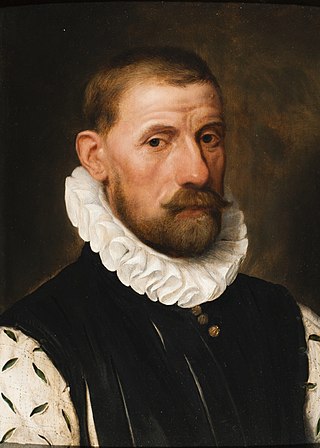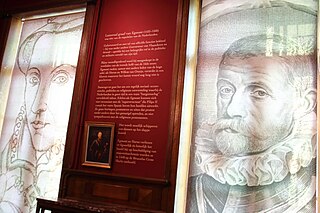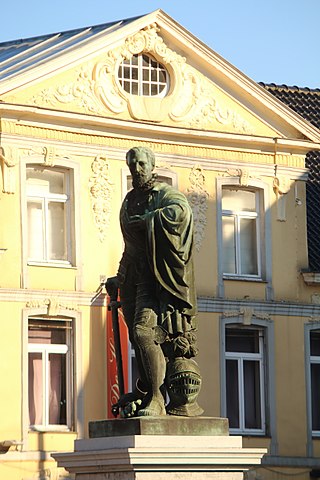
Taranaki is a region in the west of New Zealand's North Island. It is named after its main geographical feature, the stratovolcano Mount Taranaki, also known as Mount Egmont.

Ellezelles is a municipality of Wallonia located in the province of Hainaut, Belgium.

Lamoral, Count of Egmont, Prince of Gavere was a general and statesman in the Spanish Netherlands just before the start of the Eighty Years' War, whose execution helped spark the national uprising that eventually led to the independence of the Netherlands.

Mount Taranaki is a dormant stratovolcano in the Taranaki region on the west coast of New Zealand's North Island. At 2,518 metres (8,261 ft), it is the second highest mountain in the North Island, after Mount Ruapehu. It has a secondary cone, Fanthams Peak, 1,966 metres (6,450 ft), on its south side.

Philip de Montmorency, also known as Count of Horn, Horne, Hoorne or Hoorn, was a victim of the Inquisition in the Spanish Netherlands.

Cape Egmont, splitting Northern and Southern Taranaki Bights, is the westernmost point of Taranaki, on the west coast of New Zealand's North Island. It is located close to the volcanic cone of Mount Taranaki or Mount Egmont.

The House of Egmond or Egmont is named after the Dutch town of Egmond, province of North Holland, and played an important role in the Netherlands during the Middle Ages and the Early modern period. The main lines Egmond-Geldern, Egmond-Gavere and Egmond-Buren-Leerdam had high noble, princely rank.

The Egmont Group of Financial Intelligence Units is an international organization that facilitates cooperation and intelligence sharing between national financial intelligence units (FIUs) to investigate and prevent money laundering and terrorist financing. National FIUs collect information on suspicious or unusual financial activity and are responsible for processing and analyzing the information received. FIUs are normally not law enforcement agencies themselves, findings are shared with appropriate law enforcement or prosecution bodies if sufficient evidence of unlawful activity is found. The Egmont Group is headquartered in Ottawa, Ontario, Canada.

The Egmont Palace, also sometimes known as the Arenberg Palace, is a neoclassical palace in Brussels, Belgium. It was originally built between 1548 and 1560 for Countess Françoise of Luxembourg and Count Lamoral of Egmont, though its appearance was heavily modified in the 18th and 19th centuries. It was partly destroyed by fire in 1892, after which it was once again reconstructed. Nowadays, it is used by the Belgian Ministry of Foreign Affairs for receptions, as a guest house and conference centre.

Gaasbeek Castle is a castle located in Lennik, Flemish Brabant in Belgium. Nowadays, it serves as a national museum.

Anna van Egmont, mainly known as Anna van Buren, was a Dutch heiress who became the first wife of William the Silent, Prince of Orange.

Egmond Castle, also called the Ruins of Egmond, is a ruined medieval castle in the Dutch province of North Holland. It is located in Egmond aan den Hoef in the municipality of Bergen and lies about 7 kilometres (4.3 mi) west of Alkmaar. The castle dates from the 11th century and is the ancestral seat of the Egmond family, whose members became sovereign Dukes of Guelders, Counts of Egmond and Princes of Gavere, Counts of Buren and Leerdam. It is a national monument of the Netherlands.
Hawera was a parliamentary electorate in the South Taranaki District of New Zealand from 1896 to 1908. It was represented by two Members of Parliament over the four parliamentary terms of its existence.
The Mount Egmont Branch was a short but steep branch railway line in Taranaki, New Zealand, built to supply rail ballast for the Taranaki and Whanganui districts from a quarry on Mount Taranaki. Although officially known as a branch, the line was more akin to an industrial siding, with only ballast being carried.

The Château de Lahamaide was a castle in Lahamaide in Hainaut, located in the municipality of Ellezelles, Belgium. It was the place of birth of Lamoral, Count of Egmont. Nowadays the stables only remain.

Egmont Castle or the Castle of Egmont is a castle in Zottegem, Belgium. It has been declared a cultural heritage monument.

The Egmont Museum is a museum about Lamoral, Count of Egmont in the former Town Hall of Zottegem, Belgium.

Egmont's crypt is a crypt on the market square in Zottegem, Belgium. The crypt contains the remains of Lamoral, Count of Egmont and his wife Sabina, Duchess of Bavaria.

The Statue of Egmont is a statue of Lamoral, Count of Egmont in Zottegem, Belgium, dating from 1872.
















